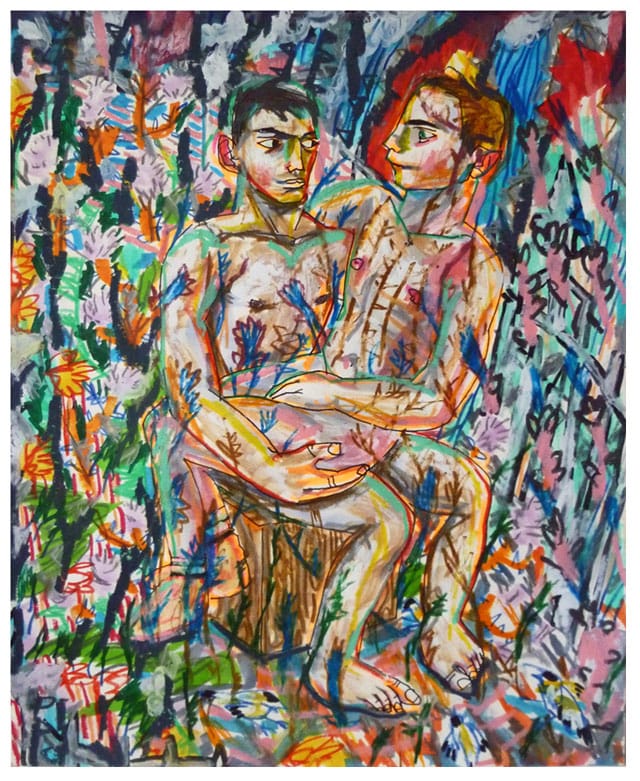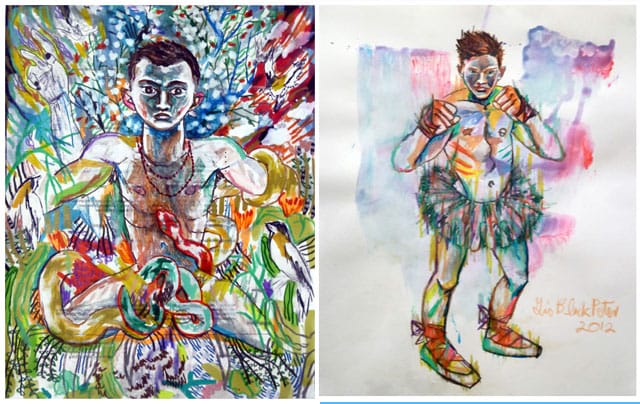Neon Jolts Done Right
Gio Black Peter pulls off some brilliant effects with markers. His current body of work at the Munch Gallery, juxtaposed against drawings by other artists in a summer group show, gets a ton of mileage out of hurling a jolt of neon at the viewer.

Gio Black Peter pulls off some brilliant effects with markers. His current body of work at the Munch Gallery, juxtaposed against drawings by other artists in a summer group show, gets a ton of mileage out of hurling a jolt of neon at the viewer. It is a chance to re-think where marker ink and bursts of fluorescence can take us in a picture.

Black Peter grasps that a little neon goes a long way. There can be too much of a good thing and generosity towards bright colors can backfire into garishness. A point not lost on this artist. Employed selectively and strategically in his mixed media drawings, these glowing spots shine like stars in a dark sky. “Cry Baby” (2012) captures the moment right before a boy begins to cry with ironically glowing highlights. Most of the picture is built up with acrylic, oil pastel and colored pencil. Against these more opaque and tame tonalities, the streaks of fluorescent marker can scream.
Neon’s formal electricity is amped up by the frenetic and feral lines that run wild in these drawings. There is sense of motion in these lines, partly because they convey the raw movements of the artist’s hand, and partly because they have a raw, un-tamed, sketchy, jumpy, unfinished quality. In “Cry Baby,” the eyebrows fray, his head of hair leaps about in different directions, and the peach lines on cheek look like they are measuring an earthquake. These lines flicker with a raw charge of energy.
This formal charge of frenetic lines and fluorescent color is mirrored by a erotic charge in the content of many of the works. “Cry Baby” epitomizes the awkward hotness of a young man. He is insecure and unsure about his place in the world, ruled more by his whims than his judgment, which gets him into trouble, but nevertheless glowing with a dashing handsome appearance. Black Peter captures this contradictory mixture of good looks, pain, insecurity and energy at the heart of youth so eloquently with his wild lines and neon bursts. This picture was hard one to leave at the gallery.

Another work, “Fragmentation” (2012), should be submitted to urban dictionary to illustrate what Drag Queens mean by fierce. A young man wears a tutu, sandals (ballet shoes?), gloves and nothing else. Wild streaks of fluorescent color swirl across the picture plane disregarding the boundaries of his silhouette. Clouds of color bleed into one other in the background, threatening to upstage our ballerino. These formal devices don’t give a shit about the rules, or perhaps they follow their own invented dictums. It is a brazen and brash style that reinforces the rule-breaking content.
Gio Black Peter’s landscapes look like a field of Fleur-de-Lis on acid. Like the medieval tradition of cramming as many little flowers as possible into a landscape, exemplified by the Unicorn Tapestries at the Cloisters, no space is left bare — horror vacui. The acid comes in with the bright colors and jagged lines that depict the field in Black Peter’s work. In “Resuscitate” (2012), the two men almost get lost in a heavy thicket of weeds and flowers. The artist’s sweet spot for gardening reveals itself in his passion for rendering each small petal, leaf and stem in his rich idiom of glowing color and chaotic line and glowing color.
Gio Black Peter makes magic with his bursts of neon and streaks of fluorescent light. This formal electricity not only dazzles the eye, it also accentuates the psychological electricity beneath the surface in each work’s content. The medley of highlight and shadow may stretch back to Caravaggio, but Black Peter is hitting these notes with a funk that classical chriaoscuro can’t touch.
Leaning into Verse a summer group show of drawings, will be on view at the Munch Gallery (245 Broome Street, Lower East Side, Manhattan) through July 15.





